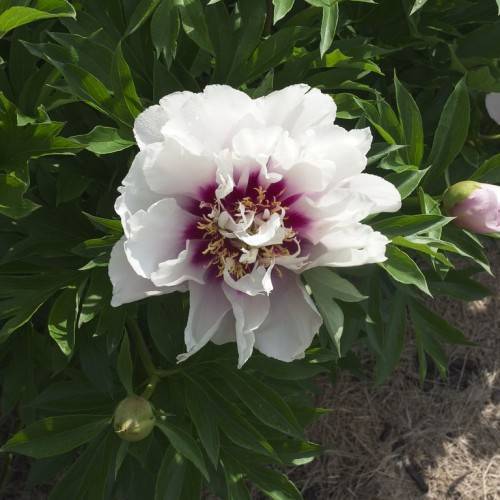
peony
Paeonia 'Cora Louise'
Cycle:
Herbaceous Perennial
Watering:
Average
Hardiness Zone:
4 - 8
Flowers:
Flowers
Sun:
Full sun,part shade
Leaf:
Yes
Growth Rate:
Low
Maintenance:
Moderate
watering
The recommended watering schedule for a peony such as 'Cora Louise' is to water deeply once weekly. The soil should be kept moist, but not soggy, as this can encourage root rot. To ensure adequate water penetration, a thorough initial watering should be done so that it is soaked for the first time in order to get the root system established. During this period, the soil should be checked and moistened regularly with 1 inch of water per week during the growing season, over the course of 2 or 3 waterings depending on soil and weather conditions. During drought periods, more frequent waterings may be needed. Before applying water, the soil should be checked for proper drainage. If water pools, the area should be aerated or the plant should be moved to a better drained location.
sunlight
Peony (Paeonia 'Cora Louise') requires full sun to achieve optimal blooms and foliage. It should receive at least 6-8 hours of direct, unfiltered sunlight per day, and can tolerate slightly more than that as well. If planted in an area with partial shade, it will still bloom, although not as heavily or with as many blooms as it would in full sun. Additionally, the foliage quality may be diminished when grown in too much shade. Planting in full sun will ensure that the peony will flower at its peak each season.
pruning
The best time to prune peonies (Paeonia 'Cora Louise') is in the fall after the first frost has occurred, when the foliage turns yellow and starts to die back. Carefully remove the spent and diseased stems near the ground level, but take care to not damage the growing buds. Any hard pruning should be done in early spring each year. Prune off any dead, diseased, or damaged stems, then shorten the previous year’s growth back to 4 to 6 inches above soil level. This will encourage more flower stems and denser foliage. Don’t be too aggressive when pruning peony shoots - you don’t want to bottom out the bush and kill all the new buds.
FAQ
Is the Peony popular flower in Canada?
Yes, the peony is a popular flower in Canada. It is highly prized for its showy blooms and long-lasting beauty. Peonies have been cultivated in Canada for centuries, and their popularity is due in part to their long-lasting blooms and hardiness in colder temperatures. Peonies are a popular choice in Canadian gardens, and flower arrangements. They are also used in bouquets and centerpieces, where their stunning colors really shine.
Are Peonies fragrant?
Yes, peonies are quite fragrant. Depending on the variety of peony, the scent can be described as sweet, floral, and citrusy. Some of the most popular and aromatic varieties of peony include 'Pillow Talk', 'Fairy Tale', and the 'Duchess De Nemours'. Peonies are often used in floral arrangements and can even be grown in your garden for a fresh, summery scent.
Can Peonies be grown in partial shade?
Yes, peonies can be grown in partial shade. While they require at least 6 hours of sunlight per day during the first half of the growing season, the second half is best if the plants can receive a few hours of shade. As long as the area is not completely shaded, the peonies should do well. These plants are also hardy, so they can generally thrive in a variety of locations.
Do Peonies require well-drained soil?
Yes, peonies do require well-drained soil in order to grow and flourish. Planting them in heavy clay soil can cause the roots to rot, as the soil will stay wet for too long. To ensure good drainage and aeration, it is recommended that the soil is amended with organic matter like compost or peat moss. The soil should also be slightly acidic, with a pH of 6.0-7.0. Additionally, peonies may need to be watered more often during the summer, as they are prone to wilt in hot temperatures.
Should Peonies be staked to prevent damage?
Yes, it is a good idea to stake peonies to prevent damages. Peonies are naturally tall and floppy flowers and as such, can easily be damaged by strong winds and heavy rain. Staking is a great way to keep tall peonies from sprawling or falling over which could damage the stems or flowers. When staking your peony, use tall, sturdy stakes that support the main stem of the plant. You can use metal or bamboo stakes, but be sure to avoid stakes with sharp edges or points as those could damage the plant or injure those tending the garden. Utilizing a supporting structure for your peony will help it to look its best.
Is the Peony a long-lived perennial plant?
Yes, the Peony is a long-lived perennial plant. It can live for more than 20 years in the proper conditions, and can even last for generations with proper care and maintenance. Peonies prefer cooler climates, and well-drained soil with a relatively high pH level. They will grow to approximately 2 -3 feet in height, with heart-shaped foliage and blooms in shades of white, pink, and red. Peonies typically bloom in late spring or early summer months and make an excellent addition to any garden.
